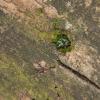Western monarchs experienced a 58% seasonal decrease between the Thanksgiving and New Year’s counts
The Xerces Society’s Western Monarch Count results for the New Year’s period are now in, revealing a 58% seasonal decrease in the overwintering western monarch population. Although the overall number of western monarchs counted for the New Year’s count remains relatively high compared to recent years — with more than 116,000 butterflies reported — the 58% seasonal decrease exceeds the typical range of 35–49% observed over the previous six winters.
The decrease is based on monitoring at 169 overwintering sites visited during both the Thanksgiving and New Year’s count periods by community science volunteers and partners. The New Year’s count serves as a follow-up to the annual Thanksgiving count to help scientists track how the western monarch population changes throughout the overwintering season as well as providing an estimate of how many butterflies remain to begin the spring breeding population. Read this year’s Thanksgiving count announcement.
The seasonal decrease is likely due to a combination of factors: mortality from winter storms, predation and other causes, as well as butterflies leaving the overwintering sites. As climate change and other factors like habitat loss and pesticides continue to imperil the monarch butterfly, conservation efforts and legal protections are becoming increasingly important.
“Small populations are particularly vulnerable to being snuffed out by extreme weather, so we are lucky these storms occurred in a relatively good year,” said Emma Pelton, a conservation biologist at the Xerces Society and western monarch lead. “We don’t want to count on luck alone to ensure the survival of the western monarch migration.”

Volunteers turn out impressive survey effort despite the downpour
Even with severe back-to-back storms, Western Monarch Count participants surveyed a total of 177 western monarch overwintering sites and estimated 116,758 butterflies for the New Year’s count, which ran from December 24, 2022, through January 8, 2023. New Year’s count data is available on the Western Monarch Count website.
Of the 169 sites monitored during both the Thanksgiving and the New Year’s counts, monarch estimates declined at 119 sites, increased at 14 sites, remained unchanged at one site, and 34 sites hosted zero monarchs during both counts. The majority of overwintering butterflies were observed along the Central Coast, with approximately 49% of butterflies reported in San Luis Obispo County, 28% in Santa Barbara County, 11% in Monterey County and 10% in Santa Cruz County.
While some sites host monarchs all winter long, others are only used for a few months or weeks. These sites are still overwintering sites, but are considered to be more temporary or transitional sites, suggesting they provide less-than-ideal habitat quality. Monitoring several times throughout the overwintering season helps scientists better understand how monarch butterflies are using overwintering sites and which sites would benefit most from active management and protection.

Storms impacted many sites
Volunteers and partners observed flooding, downed and damaged trees, butterfly movement and butterfly mortality at many overwintering sites due to the storms. Notably, a major cluster tree at California State Park’s Pismo Beach Monarch Butterfly Grove fell due to saturated soil. Tree replanting efforts are underway at that site. A number of sites were inaccessible due to road closures and unsafe conditions, so their condition is not yet known. Other sites escaped relatively unscathed.
“If there is a silver lining to the storm damage this year, it is hopefully that more people are recognizing the importance of resilient, well-managed and protected habitats,” says Isis Howard, a conservation biologist at the Xerces Society.
The majority of western monarch overwintering sites continue to suffer from a lack of active management, disease, and/or drought. A substantial number of overwintering sites currently face imminent development risks, including Hayward Golf Course, a significant overwintering site in the East Bay which is being proposed as the site of a future business park and airport expansion. Read more about “The Vanishing Butterfly Groves of California” here.
The results of this year’s count underscore the urgent need for effective conservation strategies to protect western monarchs and their habitat. The Xerces Society, in partnership with other conservation organizations and agencies, is working to protect monarchs and their habitats. This includes restoring overwintering sites, planting native milkweed, and creating conservation plans. We hope that you will join us.

Take action
Here are five simple ways you can support monarch butterflies:
- Plant native milkweed.
- Plant a diversity of native nectar plants.
- Reduce your reliance on pesticides and advocate for pollinator-safe nursery plants.
- Call on legislators to support greatly needed policies such as Recovering America’s Wildlife Act and the Monarch Action, Recovery, and Conservation of Habitat Act.
- Contribute to community science projects that track monarchs, such as the Western Monarch Milkweed Mapper, Western Monarch Mystery Challenge, and nationwide Integrated Monarch Monitoring Program.
The Xerces Society has been active in monarch and pollinator conservation in California for decades. Xerces' work helps restore monarch overwintering sites, expand pollinator habitat on farms, and has distributed more than 130,000 pollinator plants through Xerces’ Habitat Kit Program. This program provides plants to partners creating habitat in working lands, public lands, and tribal lands. Project proposals for the California kits will be accepted until April 3, 2023. Submit a habitat kit proposal now!
Share monarch sightings this spring and summer
The Western Monarch Milkweed Mapper is a community science project where you can report monarch and milkweed sightings year-round to help scientists better understand where monarchs (adults, eggs, larvae, and pupae) and their host plants occur in the landscape. Volunteers can submit their observations to the website or post to iNaturalist and tag the Western Monarch Milkweed Mapper project. (Note that the Western Monarch Milkweed Mapper is not intended to capture overwintering monarch observations, and overwintering/clustering monarch observations should be sent to the Western Monarch Count project.)
For those who live in California, the Western Monarch Mystery Challenge is an extra push to collect monarch observations in the spring as they leave their overwintering grounds. Solving this mystery is central to conserving and restoring the phenomenon of monarch migration in the West. To participate in the Western Monarch Mystery Challenge, report your monarch sightings from February 14 through April 22 to the Western Monarch Milkweed Mapper website or iNaturalist project, or email [email protected]. All data eventually ends up in the Western Monarch Milkweed Mapper.

Acknowledgements
A huge thank you to the more than 250 dedicated volunteers and partners who collected data at overwintering sites. Thank you to our western monarch conservation funders, who make this work possible: Bureau of Land Management, California Department of Fish and Wildlife, California State Parks Foundation, California Wildlife Conservation Board, Google.org, US Forest Service International Programs, The Marion R. Weber Family Fund, Monarch Joint Venture, National Fish and Wildlife Foundation, Natural Resources Conservation Service, San Diego Zoo Wildlife Alliance, The Taggart Saxon Schubert Fund, US Fish and Wildlife Service, and Xerces Society members.




